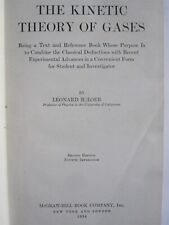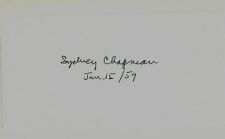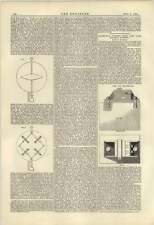"Kinetic Theory of Gases" Sydney Chapman Hand Signed 3X5 Card For Sale

When you click on links to various merchants on this site and make a purchase, this can result in this site earning a commission. Affiliate programs and affiliations include, but are not limited to, the eBay Partner Network.
"Kinetic Theory of Gases" Sydney Chapman Hand Signed 3X5 Card:
$349.99
Up for sale a RARE! "Kinetic Theory of Gases" Sydney Chapman Hand Signed 3X5 Card Dated 1959. This sale also includes a hand written note on an ALS.
ES-3742
and the Earth's ozone layer has inspired a broad range of research over
many decades. Chapman was born in Eccles, near Salford in
England and began his advanced studies at a technical institute, now the University of Salford, in
1902. In 1904 at age 16, Chapman entered the University of Manchester.
He competed for a scholarship to the university offered by his home county, and
was the last student selected. Chapman later reflected, "I sometimes
wonder what would have happened if I'd hit one place lower." He
initially studied engineering in the department headed by Osborne Reynolds. Chapman was taught mathematics by Horace Lamb, the Beyer professor of mathematics, and J. E. Littlewood, who came
from Cambridge in Chapman's final year at Manchester. Although he graduated
with an engineering degree, Chapman had become so enthusiastic for mathematics
that he stayed for one further year to take a mathematics degree. Following
Lamb's suggestion, Chapman applied for a scholarship to Trinity College, Cambridge.
He was at first awarded only a partial scholarship as a sizar (meaning
that he obtained financial support by acting as a servant to other students),
but from his second year onwards he received a full scholarship. He graduated
as a wrangler in
1910. He began his research in pure mathematics under G. H. Hardy, but later that year was asked by Sir Frank Dyson to be
his chief assistant at the Royal Greenwich Observatory.[ From 1914 to 1919,
Chapman returned to Cambridge as a lecturer in mathematics and a fellow of
Trinity. He held the Beyer Chair of Applied
Mathematics at Manchester from 1919 to 1924, the same position
as had been held by Lamb, and then moved to Imperial College London.
During the Second World War he
was Deputy Scientific Advisor to the Army Council.
In 1946, Chapman was elected to the Sedleian
Chair of Natural Philosophy at Oxford, and was appointed fellow
of The Queen's College,
Oxford. In 1953, on his retirement from Oxford, Chapman took
research and teaching opportunities all over the world, including at
the University of Alaska and
the University of Colorado,
but also as far afield as Istanbul, Cairo,
Prague, and Tokyo. As the Advisory Scientific Director of the University of
Alaska Geophysical Institute from
1951 to 1970, he spent three months of the year in Alaska, usually during winter for research into auroras. Much
of the remainder of the year he spent at the High Altitude Observatory in
Boulder, Colorado. Chapman's most noted
mathematical accomplishments were in the field of stochastic processes (random
processes), especially Markov processes. In his study of Markovian stochastic
processes and their generalizations, Chapman and the Russian Andrey Kolmogorov independently developed the pivotal set
of equations in the field, Chapman is credited with working out, in 1930, the
photochemical mechanisms that give rise to the ozone layer.
Chapman is recognised as one of the pioneers of solar-terrestrial
physics. This interest stemmed from his early work on
the kinetic theory of gases. Chapman studied magnetic storms and aurorae, developing
theories to explain their relation to the interaction of the Earth's magnetic field with
the solar wind. He disputed and ridiculed the work of Kristian Birkeland and Hannes Alfvén, later adopting Birkeland's theories as his own. Chapman
and his first graduate student, V. C. A.
Ferraro, predicted the presence of the magnetosphere in the early 1930s. They also predicted
characteristics of the magnetosphere that were confirmed 30 years later by
the Explorer 12 satellite.
In 1940, Chapman and a German colleague Julius Bartels published a book in two volumes on
geomagnetism, which was to become the standard text book for the next two
decades In 1946 Chapman coined the term: Aeronomy, which is used today to describe the scientific field
of high-altitude research into atmosphere/space interaction.[ From 1951 to 1954, Chapman was
President of the International
Union of Geodesy and Geophysics (IUGG).[ Chapman was President of the
Special Committee for the International Geophysical
Year (IGY). The idea of the IGY stemmed from a discussion in
1950 between Chapman and scientists including James Van Allen. The IGY was held in 1957–58, and resulted in
great progress in fields including Earth and space sciences, as well as leading
to the first satellite launches.[

Related Items:
Aeronautical engineering vintage book: Kinetic Theory of Gases 1934
$9.99
"Kinetic Theory of Gases" Sydney Chapman Hand Signed 3X5 Card
$349.99
1884 Steps Towards Kinetic Theory Of Matter Sir William Thomson
$12.70



